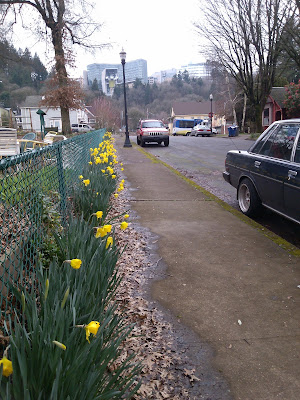I made my first batch of sauerkraut in December of 2009. Since that experiment I've had many successful ferments (and started using a real fermenting crock rather than a fish bowl), but my most recent batch may just be an epic failure.
Making a tasty ferment is always a combination of factors -- temperature, bacteria, and timing all play together in a chemical, biological dance. Prior to my most recent batch, I'd only made my kraut in the Pacific NW fall; a fall with reliably high humidity. But a reliable characteristic of my current home is aridity.
On a sunny fall day I sought out a pair of hefty cabbages at the Santa Fe farmer's market. I cradled them like babies, brought them home, and did the usual -- fine chopping, squishing with salt, and packing into my 2 gallon crock. I was impressed with the brine created from the cabbage's liquid. It covered the cabbage by a couple inches, so I didn't need to add any additional brine.
Fast forward a few days, and I check on my kraut. All of that beautiful brine evaporated! The cabbage was exposed to air, and I needed to add more liquid. Somewhere in my head I knew that I should add a brine solution (water + salt) and not just plain water. The correct salt concentration discourages the growth of gross bacteria. But I was feeling extra experimental that fateful day, or overly confident in my healthy batch of kraut, or lazy, and I decided to use plain tap water to resubmerge the cabbage.
Fast forward a few more days, and the kraut has an amazingly hairy growth of mold. I scoop it out with a big spoon, and the whole mat clings together like a weird kombucha scoby. I dig deeper into the crock and happily find that its innards are crunchy, delicious, and developing excellent kraut sourness and flavor. I fill a jar for the fridge, then pack the rest back together and place the crock gently in its fermenting corner, confident that it will be a fine batch.
But then the jar in the fridge grows soft. I fear for the whole batch, and open it (after 40 days at ~60-70 degrees F). It seems softer than normal. But it's tangy. And the smell is... interesting? I swear I detect notes of chocolate, but then I have a weird nose. All of this begs some questions: can soft sauerkraut be okay? and are my vague memories of someone telling me about their grandmother's sauerkraut crocks, and how they had a layer of mold, true? If the kraut is delicious, I will eat it. Go bravely into your fermenting future!
Saturday, December 3, 2016
Sauerkraut revisited
Labels:
autumn
,
cabbage
,
craft
,
evaporation
,
fermentation
,
sauerkraut
,
scent
Sunday, September 18, 2016
New Genera
Now in New Mexico, I'm surrounded by new plants.
A list of some of the genera I'm becoming familiar with here!
Abronia (Nyctaginaceae)
Apocynum (Apocynaceae)
Atriplex (Amaranthaceae)
Bouteloua (Poaceae)
Dalea (Fabaceae)
Dimorphocarpa (Brassicaceae)
Fallugia (Rosaceae)
Gutierrezia (Asteraceae)
Heterotheca (Asteraceae)
Hordeum (Poaceae)
Hymenoxys (Asteraceae)
Ipomopsis (Polemoniaceae) -- Ipomopsis sancti-spiritus!
Krascheninnikovia (Chenopodiaceae)
Linum (Linaceae)
Lotus (Fabaceae)
Machaeranthera (Asteraceae)
Mirabilis (Nyctaginaceae)
Monarda (Lamiaceae)
Physaria (Brassicaceae)
Ratibida (Asteraceae)
Rhus (Anacardiaceae)
Sphaeralcea (Malvaceae)
Thelesperma (Asteraceae)
Thermopsis (Fabaceae)
Verbena (Verbenaceae)
Xanthisma (Asteraceae)
A list of some of the genera I'm becoming familiar with here!
Abronia (Nyctaginaceae)
Apocynum (Apocynaceae)
Atriplex (Amaranthaceae)
Bouteloua (Poaceae)
Dalea (Fabaceae)
Dimorphocarpa (Brassicaceae)
Fallugia (Rosaceae)
Gutierrezia (Asteraceae)
Heterotheca (Asteraceae)
Hordeum (Poaceae)
Hymenoxys (Asteraceae)
Ipomopsis (Polemoniaceae) -- Ipomopsis sancti-spiritus!
Krascheninnikovia (Chenopodiaceae)
Linum (Linaceae)
Lotus (Fabaceae)
Machaeranthera (Asteraceae)
Mirabilis (Nyctaginaceae)
Monarda (Lamiaceae)
Physaria (Brassicaceae)
Ratibida (Asteraceae)
Rhus (Anacardiaceae)
Sphaeralcea (Malvaceae)
Thelesperma (Asteraceae)
Thermopsis (Fabaceae)
Verbena (Verbenaceae)
Xanthisma (Asteraceae)
Monday, June 20, 2016
An Abundance of Strange and New Plants
I feel like I've been around the world lately, even though in truth I've visited just a few new corners of the US.
Travelling through Idaho, I stumbled upon the stunning Thomas Canyon campground, and two of my favorite plants in flower: Balsamorhiza sagittata, and Viola purpurea.
Travelling through Idaho, I stumbled upon the stunning Thomas Canyon campground, and two of my favorite plants in flower: Balsamorhiza sagittata, and Viola purpurea.
 |
| Balsamorhiza sagittata (arrowleaf balsamroot) in the Ruby Mountains' Thomas Canyon campground |
 | |
Viola purpurea (goosefoot violet)
|
At the Chicago Botanic Garden, I experienced in person for the first time two very charismatic plants: Taxodium distichum (bald cypress), and Theobroma cacao (cacao tree)!
 |
| Taxodium distichum. The knees, the knees!! |
 |
| Theobroma cacao flowers. They didn't really smell like chocolate. And why the heck do they come straight out of the bark? Why oh why, and how? |
In the Chicago Botanic Garden's arid greenhouse, I had the privilege of meeting a whole bunch of dry-adapted carbon-fixers.
 |
| Cactus flower |
 |
| weird! |
Wednesday, February 24, 2016
Friday, February 12, 2016
Snail Eggs
Looking closely in my aquarium, I found a small surprise -- snail eggs! Magnified 10x with hand lens.
Subscribe to:
Comments
(
Atom
)



